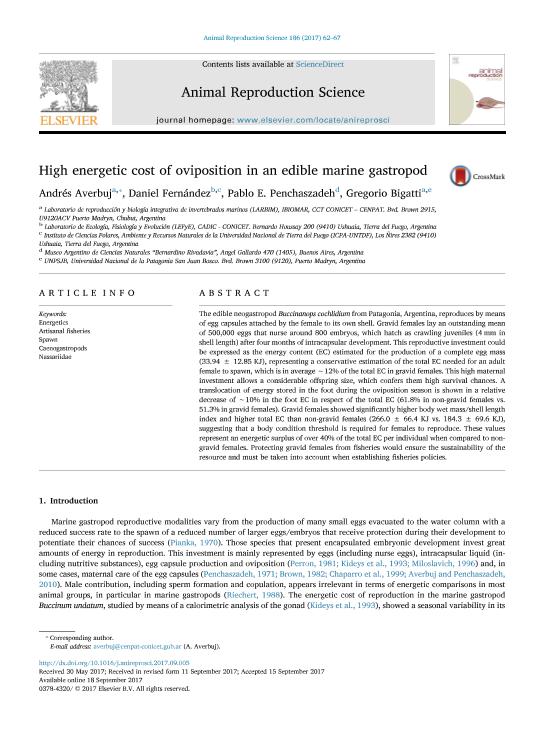Artículo
High energetic cost of oviposition in an edible marine gastropod
Fecha de publicación:
09/2017
Editorial:
Elsevier Science
Revista:
Animal Reproduction Science
ISSN:
0378-4320
Idioma:
Inglés
Tipo de recurso:
Artículo publicado
Clasificación temática:
Resumen
The edible neogastropod Buccinanops cochlidium from Patagonia, Argentina, reproduces by means of egg capsules attached by the female to its own shell. Gravid females lay an outstanding mean of 500,000 eggs that nurse around 800 embryos, which hatch as crawling juveniles (4 mm in shell length) after four months of intracapsular development. This reproductive investment could be expressed as the energy content (EC) estimated for the production of a complete egg mass (33.94 ± 12.85 KJ), representing a conservative estimation of the total EC needed for an adult female to spawn, which is in average ∼12% of the total EC in gravid females. This high maternal investment allows a considerable offspring size, which confers them high survival chances. A translocation of energy stored in the foot during the oviposition season is shown in a relative decrease of ∼10% in the foot EC in respect of the total EC (61.8% in non-gravid females vs. 51.3% in gravid females). Gravid females showed significantly higher body wet mass/shell length index and higher total EC than non-gravid females (266.0 ± 66.4 KJ vs. 184.3 ± 69.6 KJ), suggesting that a body condition threshold is required for females to reproduce. These values represent an energetic surplus of over 40% of the total EC per individual when compared to non-gravid females. Protecting gravid females from fisheries would ensure the sustainability of the resource and must be taken into account when establishing fisheries policies.
Palabras clave:
Energetics
,
Artisanal Fisheries
,
Spawn
,
Caenogastropods
,
Nassariidae
Archivos asociados
Licencia
Identificadores
Colecciones
Articulos(IBIOMAR)
Articulos de INSTITUTO DE BIOLOGIA DE ORGANISMOS MARINOS
Articulos de INSTITUTO DE BIOLOGIA DE ORGANISMOS MARINOS
Citación
Averbuj, Andres; Fernandez, Daniel Alfredo; Penchaszadeh, Pablo Enrique; Bigatti, Gregorio; High energetic cost of oviposition in an edible marine gastropod; Elsevier Science; Animal Reproduction Science; 186; 9-2017; 62-67
Compartir
Altmétricas




